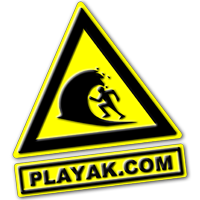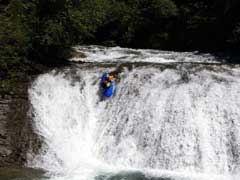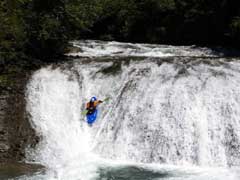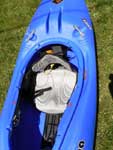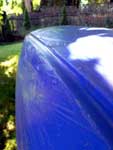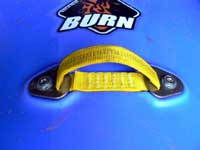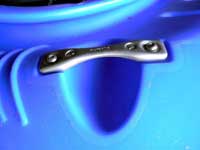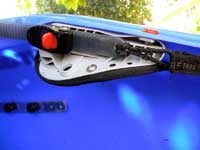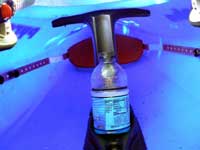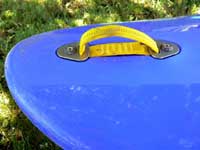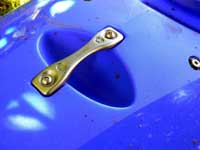[please login to make this ad block disappear]
Articles
Independent Review: Pyranha Burn
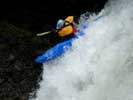 |
Independent Playak Boat Review: Pyranha Burn. |
[click photos to enlarge]
Summary
Although Pyranha markets the Burn as a 'River Runner', expect it to be used, as were its H:2 and H:3 predecessors, in a broad range of applications: as a river-runner, by folks who want a stable platform to run easy whitewater, and as a steep creeker, by those who prize its superior performance under even the most extreme of conditions. For this review, the Burn was put through its paces in both class IV boogie and Class V with significant drops.
Initial impressions
One of the most challenging things about reviewing boats is that each boat is made by and for different people, and thus each boat reflects different thinking, different styles, and rewards different approaches to paddling. Often reviewing a boat requires you to step outside your normal paddling style for a moment, to find what others will like about a given boat, even when that boat might not suit your own paddling style very well. …and then, there are those boats that suit your own paddling style so well that your buddies remark on it. For me, the Burn falls into the latter category. This boat had my buddies commenting that it made me look good. This, of course, makes the Burn a slam-dunk in my book, as I am a very, very vain man … but there's more: it's a fun boat to drive. I'd paddle this boat even if nobody was looking.
Outfitting/Features/Specs
The seat in the medium Burn was narrow enough that I took out the hip pads and paddled without them. The seat, sans pads, is a perfect fit for me (waist size: 33) when I'm in a drysuit, wearing fleece and all that. If you're much bigger than me, consider the next size up.
I moved the seat forward immediately upon receiving it, and in retrospect, didn't move it forward far enough. The boat comes with lots of foot-room, and if you're my size (inseam 32”, size 9 feet) you'll want to move the seat from its space-maximizing default spot to someplace that trims you out better. Moving the seat is easier than it was in earlier incarnations of this boat - there are no back-side bolts to lose under the seat(the bolts are integrated into the plate that hangs the seat) - but it does still involve reaching around the side of the seat. This seat won't slide or adjust once fixed, which in spite of the relative inconvenience of needing a screwdriver to adjust, makes sense once it's in the spot you want it.
The boat came with two bulkheads; one small one suitable for fitting waaay down in the end of the boat, one bigger one for the rest of us with short, scrawny legs. Being of the latter persuasion, I swapped from the small, big-guy-friendly(default) bulkhead to the larger one. The operation was straightforward and required a fat Phillips-head screwdriver, the same tool required to move the seat.
Sitting in the seat, I note that Pyranha hasn't forgotten how to engineer a seat with butt-hugging goodness, and that they still provide cavernous space under the thigh hooks - part of my outfitting to-do list involves sculpting thigh-blocks to place on the outsides of my legs. These aren't strictly necessary, but I like them and outer-thigh support occurs as missing.
The backband is adjusted by ratchets at the front of the cockpit. The backband is supportive, comfortable, and adjustable over a wide range of fore-aft spots.
Length: 245 cms / 8'
Width: 65.5 cms / 25.8"
Volume: 275 ltr / 73 gal.
Weight: 18 kgs / 40 lbs.
Cockpit:
Length: 93.5 cms / 36.8"
Width: 48.5 cms / 19.1"
Features
-
Open, easy-to-exit cockpit
- Even with the seat trimmed forward, I was able to get my knees above the cockpit rim without significant effort - in case of a pin, escaping this boat will be simple.
-
Plastic front pillar/step
- The front pillar is molded plastic, is secured to the top deck by wide screw-points, and keys solidly into the seat rail. In case of vertical pin, you'll be able to use it as a step. It's also easy to grip when portaging.
- One thing that's missing from the pillar set-up is beefy lateral support for the pillar - although it's solidly anchored from the deck-side, the whole rail can be moved side-to-side along the hull. In future incarnations, I'd like to see more lateral support for the pillar on the bottom.
-
Your choice of two footblocks
- Comes with a small footblock that'll fit the narrow area toward the end, and a bigger one for shorter legs (which will prevent your foot from going past the block).
-
Hung seat
- The seat attaches via 4 bolts and two plates next to the cockpit rim, and keys into the rail, providing hull and sidewall stiffness.
-
Rear pillar held in place by deck contours
- On the hull, the stern pillar (made of minicell) slots into the seat rail, while the stern deck dimples on either side of the pillar, holding the pillar in place.
- Rounded, up-swept bow and stern (tough to pin or key)
-
Generous two-point webbing handles
- These are easy to see, easy to grab, don't mash flat, and provide a two-point anchor
-
3 ‘security' attachment points
- The attachment points have generous pockets; these'll be easy to get a carabiner into if you need to un-pin the boat.
-
Good performance
- This boat went where I wanted it to, did what I wanted it to do, and stayed on top of the nasty bits I didn't want to be underwater in. As the proverb goes, you don't need forgiveness if you're not sinning. …and when you're in it icky, that's when you need your boat to perform. J
The volume distribution of the Burn is slightly different from earlier incarnations of the H: series; volume all the way up to the ends is more generous, and volume in the center of the boat has increased slightly.
[More detailed information (729 words, 6 images, 6 links) is available for registered Playak users - please login or create a free account first to access this extra information]
For Playak,
Chris Joosse
About the test pilot
I am 6'1”/1.85m, tip the scales at 186lbs/85kg, and have size 9US/43 feet, with 32”/81cm inseam.
I started kayaking when your standard-issue playboat started having chines, and I am most at home in a boat that has edges I can use. I'm one of those folks for whom 'round' doesn't feel more forgiving, it means I have to do everything without edges. And I *like those*.
